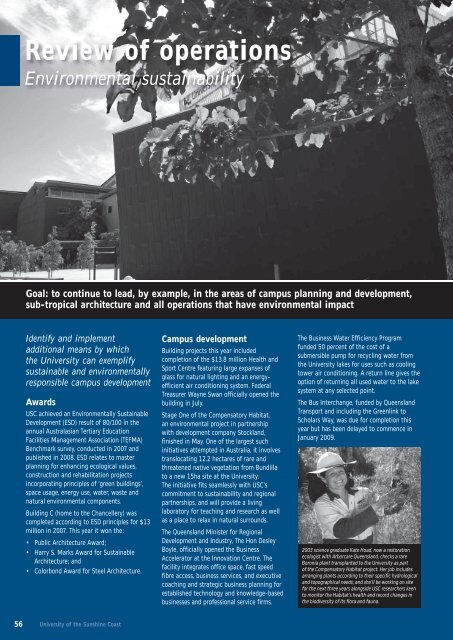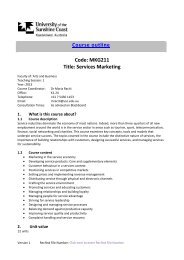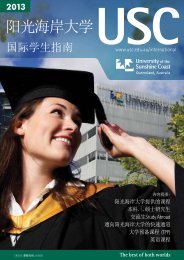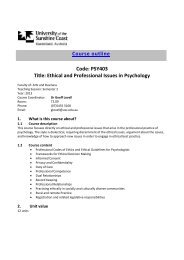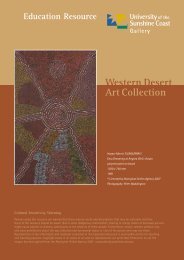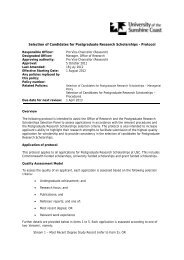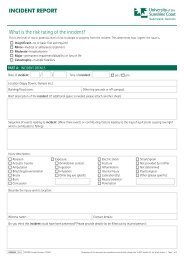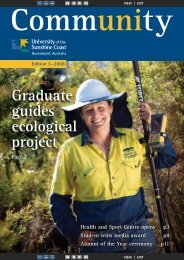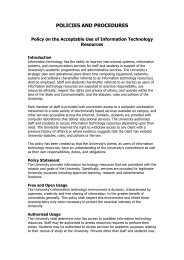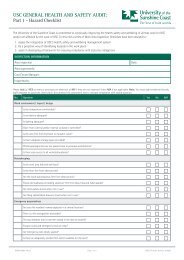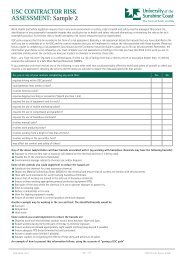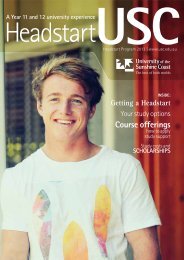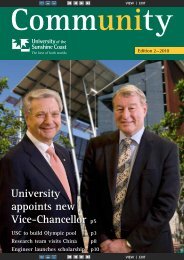Environmental sustainability - University of the Sunshine Coast
Environmental sustainability - University of the Sunshine Coast
Environmental sustainability - University of the Sunshine Coast
You also want an ePaper? Increase the reach of your titles
YUMPU automatically turns print PDFs into web optimized ePapers that Google loves.
Review <strong>of</strong> operations<br />
<strong>Environmental</strong> <strong>sustainability</strong><br />
Goal: to continue to lead, by example, in <strong>the</strong> areas <strong>of</strong> campus planning and development,<br />
sub-tropical architecture and all operations that have environmental impact<br />
Identify and implement<br />
additional means by which<br />
<strong>the</strong> <strong>University</strong> can exemplify<br />
sustainable and environmentally<br />
responsible campus development<br />
Awards<br />
USC achieved an <strong>Environmental</strong>ly Sustainable<br />
Development (ESD) result <strong>of</strong> 80/100 in <strong>the</strong><br />
annual Australasian Tertiary Education<br />
Facilities Management Association (TEFMA)<br />
Benchmark survey, conducted in 2007 and<br />
published in 2008. ESD relates to master<br />
planning for enhancing ecological values,<br />
construction and rehabilitation projects<br />
incorporating principles <strong>of</strong> ‘green buildings’,<br />
space usage, energy use, water, waste and<br />
natural environmental components.<br />
Building C (home to <strong>the</strong> Chancellery) was<br />
completed according to ESD principles for $13<br />
million in 2007. This year it won <strong>the</strong>:<br />
• Public Architecture Award;<br />
• Harry S. Marks Award for Sustainable<br />
Architecture; and<br />
• Colorbond Award for Steel Architecture.<br />
Campus development<br />
Building projects this year included<br />
completion <strong>of</strong> <strong>the</strong> $13.8 million Health and<br />
Sport Centre featuring large expanses <strong>of</strong><br />
glass for natural lighting and an energyefficient<br />
air conditioning system. Federal<br />
Treasurer Wayne Swan <strong>of</strong>ficially opened <strong>the</strong><br />
building in July.<br />
Stage One <strong>of</strong> <strong>the</strong> Compensatory Habitat,<br />
an environmental project in partnership<br />
with development company Stockland,<br />
finished in May. One <strong>of</strong> <strong>the</strong> largest such<br />
initiatives attempted in Australia, it involves<br />
translocating 12.2 hectares <strong>of</strong> rare and<br />
threatened native vegetation from Bundilla<br />
to a new 15ha site at <strong>the</strong> <strong>University</strong>.<br />
The initiative fits seamlessly with USC’s<br />
commitment to <strong>sustainability</strong> and regional<br />
partnerships, and will provide a living<br />
laboratory for teaching and research as well<br />
as a place to relax in natural surrounds.<br />
The Queensland Minister for Regional<br />
Development and Industry, The Hon Desley<br />
Boyle, <strong>of</strong>ficially opened <strong>the</strong> Business<br />
Accelerator at <strong>the</strong> Innovation Centre. The<br />
facility integrates <strong>of</strong>fice space, fast speed<br />
fibre access, business services, and executive<br />
coaching and strategic business planning for<br />
established technology and knowledge-based<br />
businesses and pr<strong>of</strong>essional service firms.<br />
The Business Water Efficiency Program<br />
funded 50 percent <strong>of</strong> <strong>the</strong> cost <strong>of</strong> a<br />
submersible pump for recycling water from<br />
<strong>the</strong> <strong>University</strong> lakes for uses such as cooling<br />
tower air conditioning. A return line gives <strong>the</strong><br />
option <strong>of</strong> returning all used water to <strong>the</strong> lake<br />
system at any selected point.<br />
The Bus Interchange, funded by Queensland<br />
Transport and including <strong>the</strong> Greenlink to<br />
Scholars Way, was due for completion this<br />
year but has been delayed to commence in<br />
January 2009.<br />
2003 science graduate Kate Hoad, now a restoration<br />
ecologist with Arborcare Queensland, checks a rare<br />
Boronia plant transplanted to <strong>the</strong> <strong>University</strong> as part<br />
<strong>of</strong> <strong>the</strong> Compensatory Habitat project. Her job includes<br />
arranging plants according to <strong>the</strong>ir specific hydrological<br />
and topographical needs; and she’ll be working on site<br />
for <strong>the</strong> next three years alongside USC researchers keen<br />
to monitor <strong>the</strong> Habitat’s health and record changes in<br />
<strong>the</strong> biodiversity <strong>of</strong> its flora and fauna.<br />
56 <strong>University</strong> <strong>of</strong> <strong>the</strong> <strong>Sunshine</strong> <strong>Coast</strong>
<strong>Environmental</strong> <strong>sustainability</strong><br />
Identify and implement costeffective<br />
measures to maintain<br />
<strong>the</strong> security and environmental<br />
integrity <strong>of</strong> <strong>the</strong> Sippy Downs<br />
campus as <strong>the</strong> surrounding<br />
urban fabric becomes more<br />
dense<br />
Campus security<br />
Capital Programs and Operations (CPO)<br />
sections, including Security, was reunified<br />
in a new building adjacent to <strong>the</strong> Arts and<br />
Social Sciences Building and this central<br />
<strong>of</strong>fice was designated a Critical Incident<br />
Response Centre for use in emergencies.<br />
The first megapixel camera was installed as a<br />
trial to boost security along <strong>the</strong> <strong>University</strong>–<br />
UniCentral pathway; and <strong>the</strong> Closed Circuit<br />
Television (CCTV) network continued to<br />
expand:<br />
• within buildings, main concourses,<br />
computer laboratories and high-risk areas;<br />
and<br />
• in new open-space areas associated with<br />
building construction.<br />
Extra fencing (including perimeter fencing)<br />
also improved security and vehicle control.<br />
Traffic and parking<br />
Opening <strong>of</strong> <strong>the</strong> Dixon Road interchange alleviated peak-hour traffic congestion at <strong>the</strong> entrance<br />
to <strong>the</strong> <strong>University</strong>, and traffic counts conducted around week six <strong>of</strong> each semester contributed to<br />
a longitudinal study monitoring vehicle movements to and from campus.<br />
The <strong>University</strong> continues to suffer from overflow parking and attendant issues; and this year two<br />
temporary overflow parking areas were stabilised with road base to accommodate some <strong>of</strong> <strong>the</strong>se<br />
vehicles.<br />
Energy consumption/expenditure<br />
Annual<br />
consumption in<br />
gigajoules (GJ)<br />
Energy<br />
consumption per<br />
EFTSL (GJ/EFTSL)<br />
2000 2001 2002 2003 2004 2005 2006 2007 2008<br />
8,956 10,597 12,048 13,027 14,596 19,867 22,200 21,976 23,664<br />
4.3 4.4 4.6 4.8 4.9 6.1 5.9 5.3 5.2<br />
Cleaning and Waste Management Services<br />
Total cost<br />
cleaning ($/EFTSL)<br />
Security<br />
2000 2001 2002 2003 2004 2005 2006 2007 2008<br />
109 118 132 132 127 110 99 136 137<br />
2000 2001 2002 2003 2004 2005 2006 2007 2008<br />
Total cost <strong>of</strong><br />
security ($/EFTSL) N/A N/A 152 193 182 158 151 148 154<br />
Workmen unload some <strong>of</strong> <strong>the</strong> 30,000 squares <strong>of</strong> habitat relocated to <strong>the</strong> USC campus.<br />
Annual Report 2008<br />
57
Review <strong>of</strong> operations<br />
<strong>Environmental</strong> <strong>sustainability</strong><br />
Promote and initiate projects<br />
and o<strong>the</strong>r activities that aid in<br />
protecting and sustaining <strong>the</strong><br />
green campus corridor linking<br />
<strong>the</strong> Sippy Downs campus with<br />
Mooloolah National Park<br />
Continuing low-key protective measures<br />
included maintaining limits on activities such<br />
as bird watching, animal monitoring and<br />
bushwalking along management trails. Bigger<br />
initiatives included completion <strong>of</strong> Stage<br />
One <strong>of</strong> <strong>the</strong> Compensatory Habitat and <strong>the</strong><br />
following World Environment Day activities:<br />
• <strong>University</strong> academics and students helped<br />
200 Year 8 students from Chancellor<br />
State College plant more than 400 swamp<br />
mahogany and pink bloodwood seedlings<br />
in College grounds. These will enhance<br />
<strong>the</strong> wildlife corridor for native animals<br />
and birds and so encourage children to<br />
care for <strong>the</strong> environment; and <strong>the</strong>y will<br />
complement a revegetation program in<br />
<strong>the</strong> Mooloolah River catchment area,<br />
likely to boost water quality in <strong>the</strong> river.<br />
• Thousands <strong>of</strong> people attended Small<br />
footprints, big steps—our region’s future,<br />
a huge festival on campus co-hosted by<br />
USC, <strong>Sunshine</strong> <strong>Coast</strong> Environment Council,<br />
<strong>Sunshine</strong> <strong>Coast</strong> Regional Council and SEQ<br />
Catchments. The event addressed ways to<br />
deal with future rapid population growth<br />
and development, and included displays<br />
by green technologies and businesses, live<br />
music, activities for children, forums and<br />
workshops. A highlight was <strong>the</strong> Mayor’s<br />
Forum discussing how <strong>the</strong> <strong>Sunshine</strong> <strong>Coast</strong><br />
might become <strong>the</strong> most sustainable region<br />
in Australia.<br />
Plan and undertake actions to<br />
increase <strong>the</strong> <strong>University</strong>’s and<br />
broader community’s awareness<br />
<strong>of</strong>, and respect for, <strong>the</strong> campus<br />
as an environmental sanctuary<br />
for all native wildlife<br />
The Compensatory Habitat preserves an<br />
entire slice <strong>of</strong> <strong>the</strong> environment for <strong>the</strong> benefit<br />
<strong>of</strong> local and wider communities, now and in<br />
<strong>the</strong> future. On a smaller scale, continuing<br />
moves aimed at <strong>sustainability</strong> included:<br />
• support for <strong>the</strong> Faculty <strong>of</strong> Science,<br />
Health and Education to monitor animals<br />
movements;<br />
• maintenance <strong>of</strong> fencing and wildlife<br />
sanctuary signage; and<br />
• continuing prohibition <strong>of</strong> domestic<br />
animals on campus.<br />
Key performance indicators<br />
Proportion <strong>of</strong> operating expenditure allocated to environmental<br />
<strong>sustainability</strong><br />
Twenty-eight percent <strong>of</strong> <strong>the</strong> $13.8 million spent on building <strong>the</strong> new Health and Sport Centre<br />
elated to sustainable initiatives. Building features taken into account included:<br />
• a naturally-ventilated foyer;<br />
• an airconditioning system designed for part-floor use as required; and<br />
• capacity for using ei<strong>the</strong>r natural ventilation or airconditioning to cool <strong>the</strong> gymnasium.<br />
Energy consumption<br />
Power usage per Gross Floor Area (GFA) was 0.4735 GJ/m2 – below annual target <strong>of</strong> 0.55 GJ/m2.<br />
Carbon emissions per GFA were 120.28 kg <strong>of</strong> CO2/m2 – below annual target <strong>of</strong> 135kg <strong>of</strong> CO2/m2.<br />
Water consumption<br />
Total water consumption per kL was 4.6/EFTSL – below annual target <strong>of</strong> 5kL per EFTSL per year.<br />
2000 2001 2002 2003 2004 2005 2006 2007 2008<br />
Total water<br />
consumption (kL)<br />
Water<br />
consumption per<br />
EFTSL (kL/EFTSL)<br />
9995 8731 10,375 13,605 15,960 17,154 20,652 20,483 20,939<br />
4.8 3.7 3.9 5.0 5.4 5.3 5.5 5.0 4.6<br />
58<br />
<strong>University</strong> <strong>of</strong> <strong>the</strong> <strong>Sunshine</strong> <strong>Coast</strong>
<strong>Environmental</strong> <strong>sustainability</strong><br />
The year 2009<br />
• The Bus Interchange, funded by Queensland Transport,<br />
will be completed following delays in 2008.<br />
• Stage II <strong>of</strong> <strong>the</strong> Compensatory Habitat is to be<br />
completed.<br />
• Design <strong>of</strong> <strong>the</strong> Building H extension for science<br />
laboratories will be undertaken.<br />
• Photovoltaic systems will be designed and constructed<br />
at Dilli Village.<br />
Annual Report 2008<br />
59


